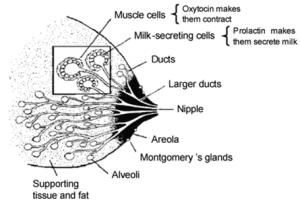Categories: Breastfeeding, Pregnancy, Pumping
July 31, 2025
Last updated on July 31, 2025
Those are some heavy words: letdown and trigger! Let’s talk about what this all means and make it a little more oxytocin-forward.
What actually makes milk flow?
There are two main hormones that directly affect breastfeeding: prolactin and oxytocin.
- Prolactin, also known as the “milk hormone,” stimulates milk production in the mammary glands
- Oxytocin, known as the “love hormone,” is responsible for the milk ejection reflex (also called the letdown reflex), which helps milk flow when a baby nurses or when using a breast pump.
Oxytocin acts as both a hormone, released to the bloodstream, and a neurotransmitter, sending signals to the brain. It causes the cells around the alveoli (milk-making glands) to contract or push milk through the ducts, which should occur within the first minute of pumping.
Fun Fact: Oxytocin also helps the uterus contract!
3 Ways Our Bodies Get Oxytocin Flowing:
- Mental/Emotional: Thinking of your baby and the love you have for them can get things flowing. Many people’s bodies get “excited” to nurse or pump that just getting into position (e.g. favorite chair, positioning baby, or grabbing pump parts) can prompt milk to start flowing!
- Sensory: Your senses play a big role. Smell, touch, sight, and sound all help to release oxytocin. Smelling your baby, touching their skin, seeing their cute cheeks, and/or hearing their little baby grunts and groans can all help in the process by lowering stress and improving your mood. Picture the new mom walking around a store hearing another baby cry and then hang to hold her arms tight to her chest to avoid leaking!
- Suckling: When baby begins to nurse, their suckling creates suction and pulls on and massages the nipple. This stimulation triggers the release of oxytocin.
How Breast Pumps Get Oxytocin Flowing:
Nipple movement and stretching helps stimulate the release of oxytocin, a hormone that supports milk letdown. When using a breast pump, the vacuum creates a negative pressure, which pulls or suctions the nipple into a breast shield tunnel, helping with milk production. This is similar to a baby suckling but limited in its effectiveness when compared to a successful and strong latch for a parent and baby dyad.
How to Simulate to Stimulate When Pumping:
To help stimulate and release oxytocin while pumping, try recreating the experience of what might occur if you were to nurse your baby instead of pumping:
- Mental/Emotional: Follow your general routine and take breaks to pump. Pumping when you would typically be nursing, or frequently throughout 24 hours if exclusively pumping, will help maintain your supply. Your body will get into a rhythm. Try not to disrupt that rhythm with added stressors like work or school – step away to pump when you can.
- Sensory Cues: Use pictures, videos, or clothing to remind your senses of your baby. If you cannot be with your baby while pumping, watching a video or smelling one of your baby’s recently worn hats can help stimulate your senses and emotions. Note, this step may even bring a few emotional tears, especially during early separation from your baby. Skin-to-skin contact and gentle breast massage (as a form of hands on pumping) can also be helpful. The keyword here is: gentle! Remember to move your hand around rather than focusing on just one spot. You can learn more about hands-on pumping here.
- Suckling: Most breast pumps have directions and/or certain modes to help mimic how a baby first sucks to get the milk flowing. Start with those beginning modes, then adjust based on how your body feels. Remember, comfort is important.
What Could Impact Your Milk Starting to Flow When Pumping
- Flange Size: Using the wrong flange size can cause a delay in your milk releasing, extending pumping sessions and possibly causing discomfort. Learn how to find the right flange size in our blog.
- Stress: Stress hormones can interfere with oxytocin and may delay your milk release. Take a few deep breaths, look at your baby (or a favorite picture/video of them), have a snack, or try to think about things other than your stressors in the moment.
Did You Know?
Some people will have a sensation when their milk begins to flow, like tingling within the nipple, but others don’t feel it at all. There is no right or wrong, but don’t be surprised if you experience this sensation. It usually only lasts a few moments.
If you ever have concerns over your milk ejection reflex, pumping, or lactation in general, do not hesitate to reach out to a local International Board Certified Lactation Consultant (IBCLC) for personalized support.
Image source: Figure 3, “Anatomy of the breast” from Session 2: The physiological basis of breastfeeding,Infant and Young Child Feeding: Model Chapter for Textbooks for Medical Students and Allied Health Professionals (World Health Organization, 2009). View original here.
Disclaimer: Image used for educational purposes only. Acelleron does not claim ownership. Content adapted from the World Health Organization via the National Library of Medicine (NCBI Bookshelf).



